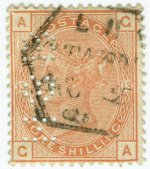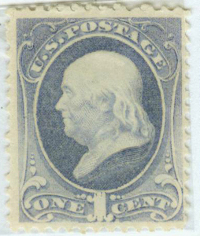
Discussion - Member to Member Sales - Research Center

Discussion - Member to Member Sales - Research Center

The 16 center must have been one of the best printed, to me it looks outstanding.
What other first airmails of 1918 to you like best?

2 Members
like this post.
Login to Like.
I like them all! Your 16 center is outstanding.

1 Member
likes this post.
Login to Like.

09:52:40pm
I like them all as well, but I think the 6 cent one is my favorite - it's the orange color I really like.

Login to Like
this post
What's not to like! Great stamps. The color seems a bit off to me though. I kind of expect to see the colors below or are there shades I don't know about?

(Stamps are not mine)

3 Members
like this post.
Login to Like.
I believe the image below is the very plane (same tail number) depicted on this series of stamps:

The Curtiss manufactured JN-4H aircraft was nicknamed the "Jenny." This single engine biplane was used during World War I by the U.S. Army Air Service. Army pilots could easily have joked that the plane was "a bunch of parts flying in formation." The pilots noted that "if you can fly a Jenny, you can fly anything!"
These planes were designed by B. Douglas Thomas. The Post Office Department began using them on May 15, 1918, when the first scheduled airmail service was instituted. Jennies were flown between Washington, D.C., Philadelphia, Pennsylvania, and New York, New York. Army pilots flew the planes for the first 2 months of the service, until the postal service was able to hire its own pilots.
The Jenny's top speed was about 80 mph, with a range of about 175 miles and a ceiling of about 11,000 feet. The plane's wingspan was 43 ft., 7 inches, and the plane weighed just over a ton. Before the planes were taken by the postal service, their 90-horsepower engines were replaced with 150 horsepower Hispano-Suiza engines. The Jenny could carry a little less than 300 pounds of mail per trip.
The front seat was left out of the redesigned planes, in order to carry mail bags. The planes' gas capacity was doubled when a set of gas tanks were hooked together so the plane could fly farther.
Sometimes a liability can also be an asset. When airmail pilot Ernest Allison was asked his opinion of the plane, he said that he considered it safe because the plane's "carburetor would vibrate the plane so badly that it would shake the ice off the wings."

4 Members
like this post.
Login to Like.
I am not a big U.S. collector..the stamps were just too expensive for me as a kid..so in my collection this is my favorite.

7 Members
like this post.
Login to Like.

Here is my C1-3 page. Note that in my collection, it doesn't matter what form it is in, as long as I have the stamp I am covered!
As in-
C1 on cover! Alvin Filstrup was a colorful collector of that era
C2 Mint Stamp
C3 Plate block of 4

3 Members
like this post.
Login to Like.
08:15:18pm
My favorite airmails.
The 16 center must have been one of the best printed, to me it looks outstanding.
What other first airmails of 1918 to you like best?

2 Members
like this post.
Login to Like.
09:24:07pm
re: Air Mails
I like them all! Your 16 center is outstanding.

1 Member
likes this post.
Login to Like.
Back when I had a bunch! I think, therefore I am - I think! Descartes, sort of!
19 Nov 2022
09:52:40pm
re: Air Mails
I like them all as well, but I think the 6 cent one is my favorite - it's the orange color I really like.

Login to Like
this post

re: Air Mails
What's not to like! Great stamps. The color seems a bit off to me though. I kind of expect to see the colors below or are there shades I don't know about?

(Stamps are not mine)

3 Members
like this post.
Login to Like.

re: Air Mails
I believe the image below is the very plane (same tail number) depicted on this series of stamps:

The Curtiss manufactured JN-4H aircraft was nicknamed the "Jenny." This single engine biplane was used during World War I by the U.S. Army Air Service. Army pilots could easily have joked that the plane was "a bunch of parts flying in formation." The pilots noted that "if you can fly a Jenny, you can fly anything!"
These planes were designed by B. Douglas Thomas. The Post Office Department began using them on May 15, 1918, when the first scheduled airmail service was instituted. Jennies were flown between Washington, D.C., Philadelphia, Pennsylvania, and New York, New York. Army pilots flew the planes for the first 2 months of the service, until the postal service was able to hire its own pilots.
The Jenny's top speed was about 80 mph, with a range of about 175 miles and a ceiling of about 11,000 feet. The plane's wingspan was 43 ft., 7 inches, and the plane weighed just over a ton. Before the planes were taken by the postal service, their 90-horsepower engines were replaced with 150 horsepower Hispano-Suiza engines. The Jenny could carry a little less than 300 pounds of mail per trip.
The front seat was left out of the redesigned planes, in order to carry mail bags. The planes' gas capacity was doubled when a set of gas tanks were hooked together so the plane could fly farther.
Sometimes a liability can also be an asset. When airmail pilot Ernest Allison was asked his opinion of the plane, he said that he considered it safe because the plane's "carburetor would vibrate the plane so badly that it would shake the ice off the wings."

4 Members
like this post.
Login to Like.

re: Air Mails
I am not a big U.S. collector..the stamps were just too expensive for me as a kid..so in my collection this is my favorite.

7 Members
like this post.
Login to Like.

re: Air Mails

Here is my C1-3 page. Note that in my collection, it doesn't matter what form it is in, as long as I have the stamp I am covered!
As in-
C1 on cover! Alvin Filstrup was a colorful collector of that era
C2 Mint Stamp
C3 Plate block of 4

3 Members
like this post.
Login to Like.

